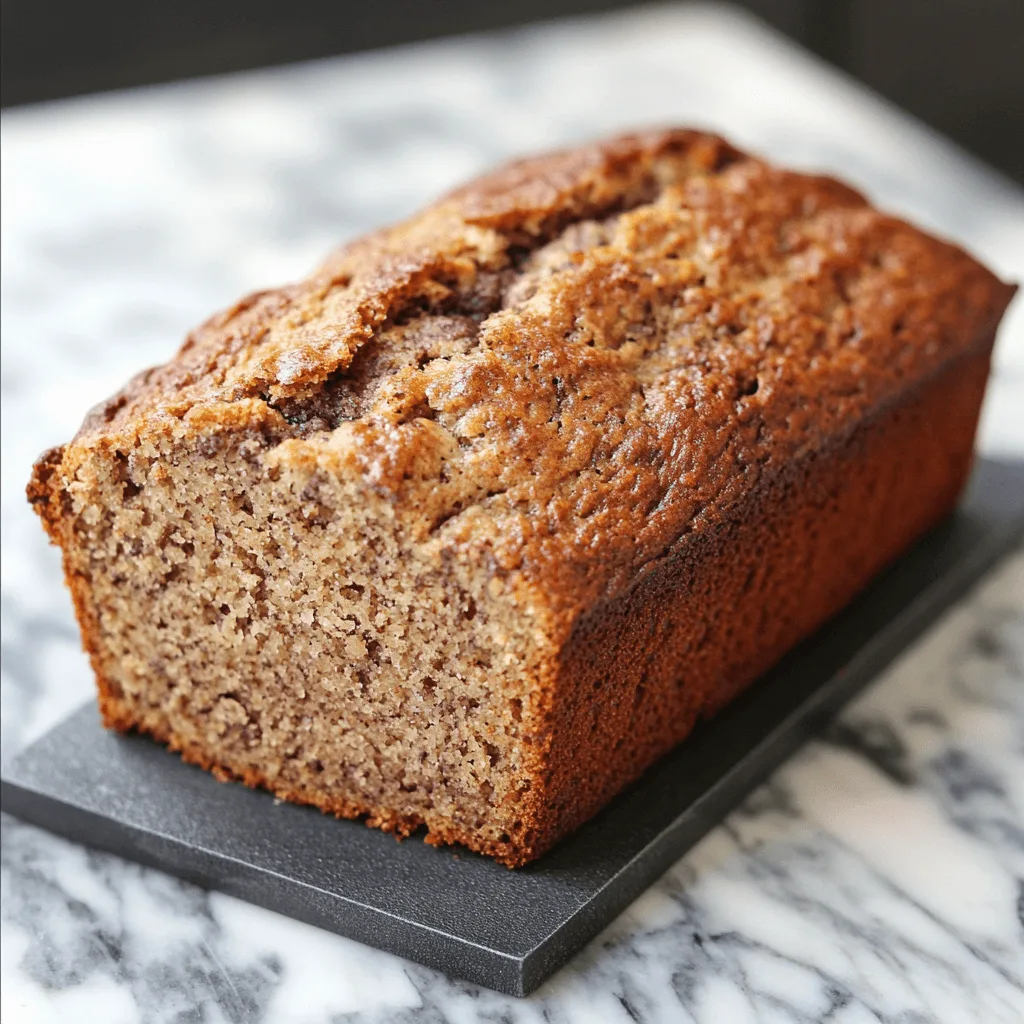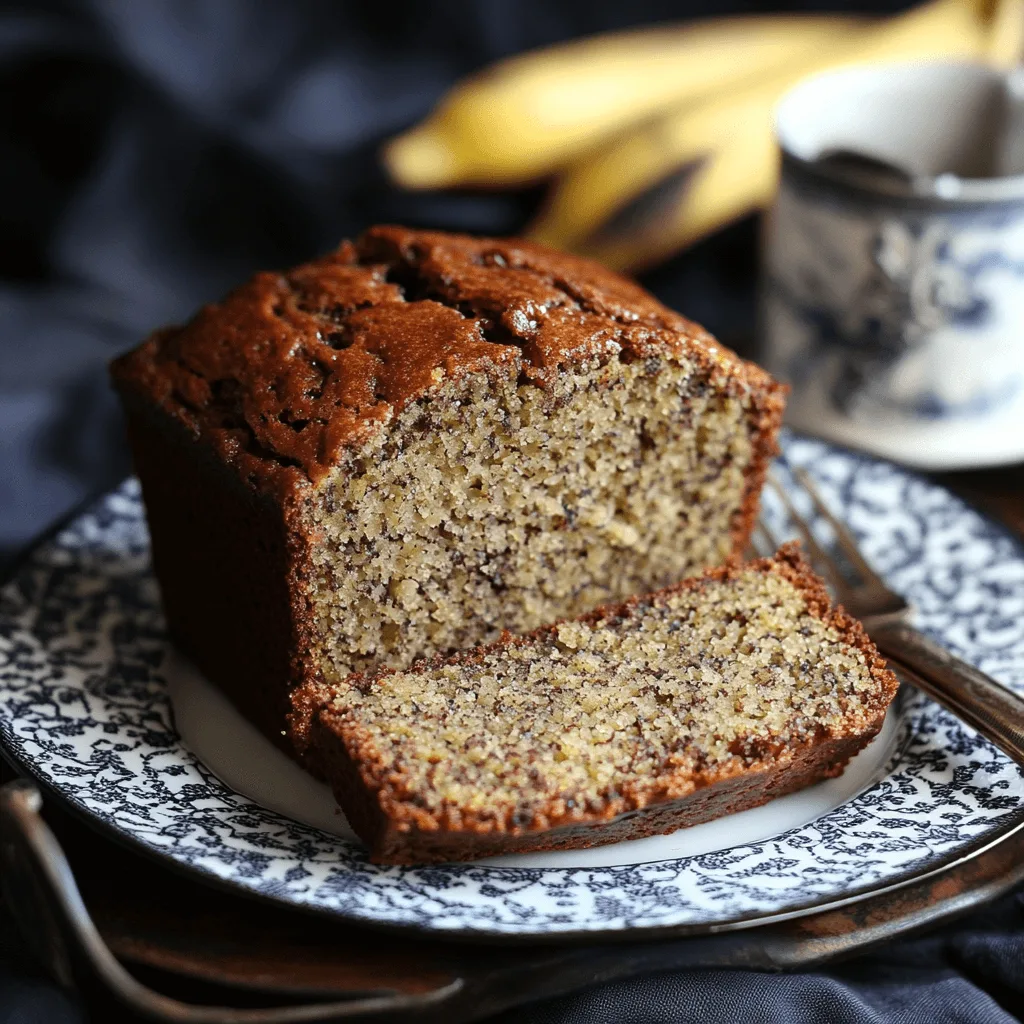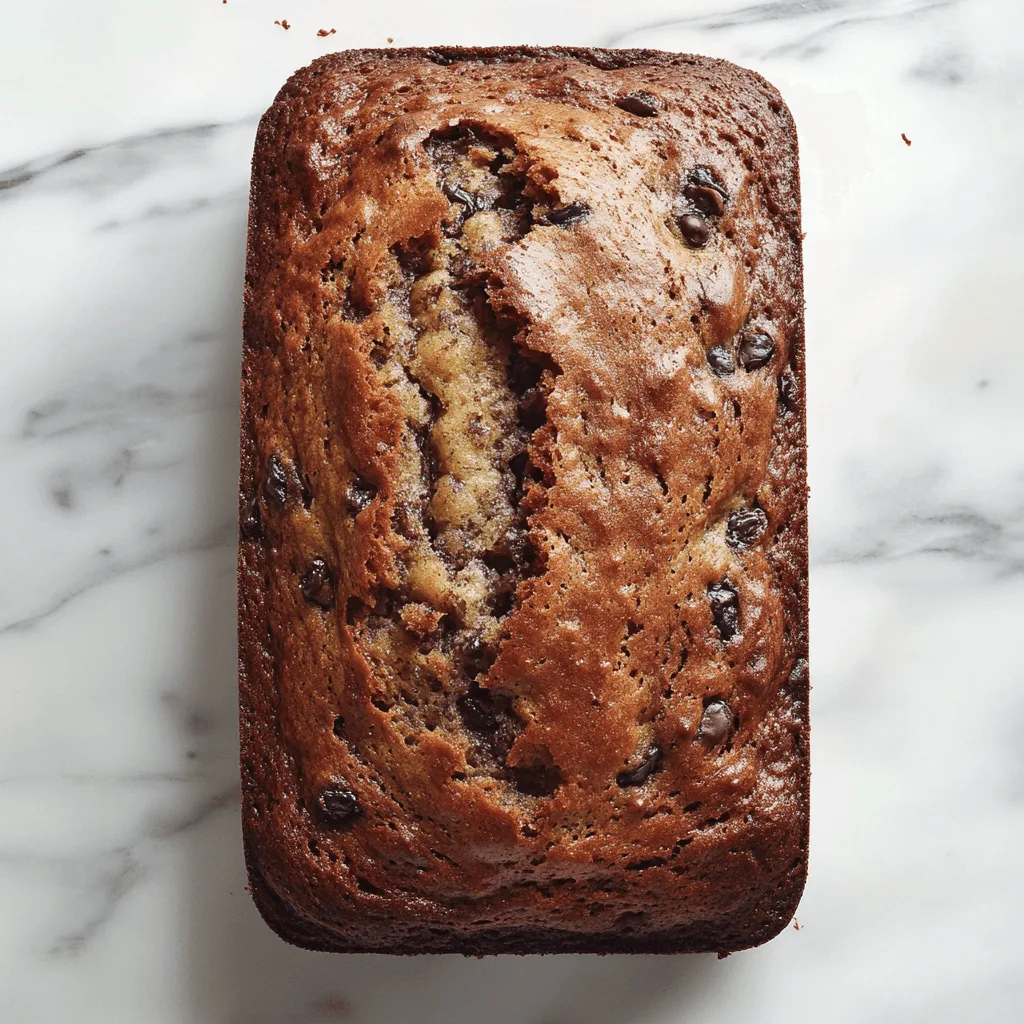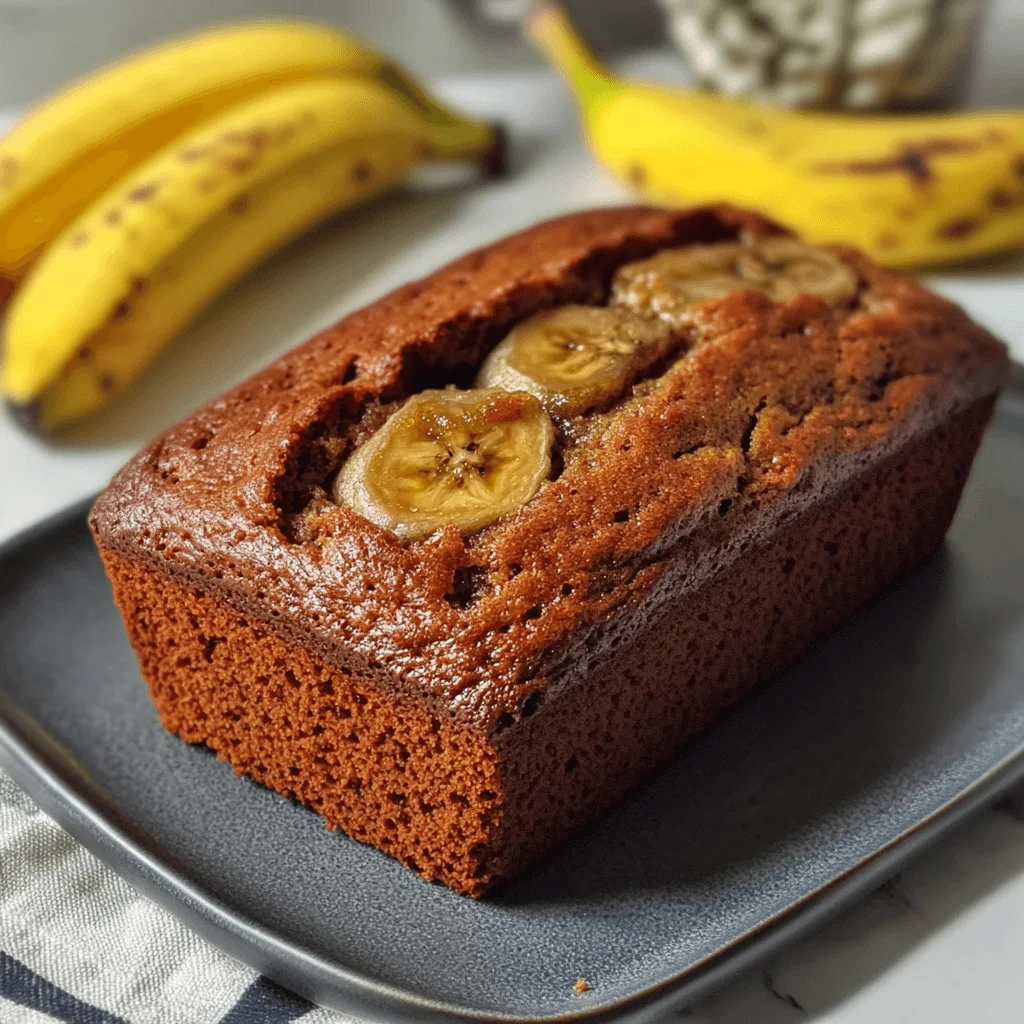There’s nothing quite like the comforting aroma of freshly baked banana bread filling your kitchen. Whether you’re an experienced baker or just starting out, mastering the perfect banana bread recipe can be a game-changer. But what makes banana bread moist, fluffy, and full of flavor? The secret lies in using the right ingredients, proper mixing techniques, and a few expert baking tips.
In this guide, we’ll walk you through everything you need to know to bake the best banana bread ever. From choosing the ripest bananas to learning pro baking tricks that prevent dryness and enhance flavor, we’ve got you covered. Plus, we’ll share common mistakes to avoid and some fun variations—like chocolate chip banana bread and healthy banana bread alternatives.
Ready to bake the ultimate banana bread? Let’s dive into the must-know ingredients, step-by-step process, and expert tips that will make your banana bread absolutely perfect!
Essential Ingredients for the Perfect Banana Bread

1. Choosing the Right Bananas 🍌
Bananas are the star ingredient in banana bread, and their ripeness makes a significant difference in texture and flavor. Here’s why choosing the right bananas is essential and how to speed up the ripening process if needed.
Why Ripe Bananas Are Best (Black-Spotted Bananas Are Ideal)
When making banana bread, the ripeness of your bananas is key. You want to use overripe bananas that have developed brown or black spots on the peel. Here’s why:
- Sweeter Flavor: As bananas ripen, their starches convert into natural sugars, giving the bread a richer and more pronounced banana flavor.
- Soft & Mashable Texture: Overripe bananas are easier to mash, blending seamlessly into the batter to create a moist and smooth consistency.
- Better Aroma & Caramelization: Riper bananas enhance the overall sweetness and depth of flavor, making your banana bread more delicious.
Pro Tip: If your bananas aren’t ripe enough, don’t worry! You can speed up the ripening process using the methods below.
How to Ripen Bananas Quickly If They’re Not Ready
If your bananas are still firm and yellow, you can use these quick ripening hacks to get them ready for baking:
- Paper Bag Method (12-24 Hours)
- Place the bananas in a brown paper bag with an apple or ripe banana.
- The ethylene gas produced by the fruit will speed up ripening overnight.
- Oven Method (15-20 Minutes at 300°F/150°C)
- Preheat your oven to 300°F (150°C).
- Place unpeeled bananas on a baking sheet and bake for 15-20 minutes until the peel turns black and soft.
- Let them cool before using.
- Microwave Method (30-60 Seconds, Immediate Use)
- If you’re in a rush, poke a few holes in the banana with a fork.
- Microwave on high for 30-60 seconds until soft.
- This works for quick softening, but won’t enhance the sweetness as much as natural ripening.
2. Flour & Leavening Agents: Getting the Right Texture
Flour and leavening agents play a crucial role in determining the texture, structure, and fluffiness of your banana bread.
All-Purpose Flour vs. Whole Wheat Flour
Choosing the right flour can make a difference in the density and taste of your banana bread.
- All-Purpose Flour (Best Choice for Classic Banana Bread)
- Produces a light, tender, and fluffy banana bread.
- Has a balanced protein content, creating the perfect crumb texture.
- Whole Wheat Flour (Healthier, But Denser)
- Adds a nutty flavor and extra fiber but makes the bread slightly denser.
- Works best when mixed with half all-purpose flour to maintain softness.
Pro Tip: If you want a healthier alternative, use a 50/50 mix of whole wheat and all-purpose flour to retain a good balance of nutrition and fluffiness.
The Role of Baking Powder & Baking Soda in Fluffiness
Both baking powder and baking soda help the banana bread rise, but they work differently.
- Baking Soda (Sodium Bicarbonate)
- Reacts with acidic ingredients (like mashed bananas, yogurt, or brown sugar).
- Creates air bubbles, helping the bread rise and giving it a light texture.
- Baking Powder
- Contains both an acid and a base, so it works without added acidity.
- Helps provide extra lift, especially when bananas are less acidic.
Pro Tip: Using both baking soda and baking powder creates the best rise and texture! A good rule of thumb is 1 teaspoon baking soda + 1 teaspoon baking powder per loaf.
3. Sweeteners & Flavor Enhancers
Sweeteners and spices enhance the taste of banana bread, giving it the right balance of sweetness and depth of flavor.
Brown Sugar vs. White Sugar for Better Taste
Both brown sugar and white sugar affect the sweetness, texture, and moisture content.
- Brown Sugar (Recommended Choice!)
- Adds deep caramel-like sweetness and extra moisture.
- Makes banana bread softer and richer.
- White Sugar
- Provides a lighter, crispier texture, but doesn’t add moisture.
- Works well when paired with honey or maple syrup for more depth.
Pro Tip: Use ½ cup brown sugar + ¼ cup white sugar for the best balance of sweetness and moisture.
Using Vanilla Extract, Cinnamon, and Nuts for Extra Flavor
Adding extra flavors elevates your banana bread:
- Vanilla Extract: Enhances the sweetness and gives the bread a more complex aroma.
- Cinnamon: Adds warmth and depth, making it taste more like a cozy homemade treat.
- Nuts (Walnuts or Pecans): Add a crunchy contrast and a slight buttery taste.
Pro Tip: Lightly toast walnuts or pecans before adding them to the batter to enhance their nutty flavor.
4. Moisture Boosters: The Secret to Soft Banana Bread
One of the biggest challenges in baking banana bread is ensuring it stays moist. Here’s how to make it soft and tender every time.
The Importance of Butter, Oil, or Yogurt for Keeping It Moist
The type of fat or dairy you use will determine how rich and moist your banana bread turns out.
- Butter (Classic Choice for Richness & Flavor)
- Adds a buttery richness and makes banana bread tender.
- Works well when combined with a small amount of oil for extra softness.
- Oil (Best for Super Moist Banana Bread)
- Helps keep banana bread soft and moist for longer.
- Use vegetable oil, coconut oil, or melted butter substitute.
- Yogurt or Sour Cream (Secret Moisture Hack!)
- Adds extra moisture without making the bread greasy.
- Slightly tangy flavor balances the sweetness.
Pro Tip: For extra moist banana bread, use ½ cup butter + ¼ cup oil OR ¼ cup Greek yogurt.
Alternative Ingredients (Banana Bread Without Butter)
If you want to make banana bread healthier or dairy-free, try these substitutes:
- Applesauce – Low-fat alternative that keeps banana bread soft.
- Mashed Avocado – Healthy fat alternative to butter.
- Coconut Milk or Almond Milk – Keeps banana bread dairy-free.
Pro Tip: If replacing butter with applesauce or yogurt, reduce sugar slightly to avoid excess sweetness.
Final Thoughts
The right ingredients make all the difference in creating the perfect banana bread. Choosing ripe bananas, the best flour, balanced sweeteners, and moisture-boosting ingredients will help you achieve a soft, fluffy, and flavorful banana bread every time.
Ready to start baking? Keep reading for the step-by-step process, baking tips, and expert tricks to perfect your banana bread! 🍌🍞
Step-by-Step Guide to Making Banana Bread

1. Prepping & Mixing Ingredients Properly
A great banana bread recipe starts with properly prepping and mixing the ingredients. Small mistakes at this stage can affect the final texture, so it’s important to follow the right techniques.
How to Properly Mash Bananas for Best Consistency
Bananas are the key ingredient in banana bread, and how you mash them affects the overall texture of your loaf.
- For smooth banana bread: Use a fork, potato masher, or electric mixer to mash the bananas into a fine, lump-free puree. This ensures an even distribution of moisture throughout the batter.
- For a chunkier texture: If you like small banana pieces in your bread, mash them lightly, leaving some small chunks for a more rustic feel.
- How many bananas to use? Most banana bread recipes call for 3 medium or 2 large bananas (about 1 cup mashed).
Pro Tip: Use overripe bananas with black or brown spots—they are sweeter, softer, and easier to mash!
One-Bowl Banana Bread Method for Easy Baking
The one-bowl banana bread method is a time-saving and mess-free approach that simplifies baking without sacrificing quality.
- Mash the bananas first in a large mixing bowl.
- Add wet ingredients (eggs, melted butter or oil, vanilla extract, and sugar). Mix well until combined.
- Sprinkle baking soda, baking powder, salt, and spices directly onto the wet ingredients before adding flour—this ensures even distribution.
- Add flour and gently fold it in until just combined.
- If using chocolate chips or nuts, fold them in last to prevent overmixing.
Why this method works: It reduces the number of dishes to clean and prevents overmixing, which can lead to dense or tough banana bread.
2. The Right Way to Mix Batter – Avoid Overmixing!
One of the biggest mistakes in baking banana bread is overmixing the batter. This can result in a dense, chewy loaf instead of a soft and fluffy one.
Why Gentle Mixing Prevents Dense Banana Bread
- Overmixing develops gluten, making the bread tougher.
- Mixing too much deflates air bubbles, resulting in a dense texture.
- The goal is to mix until the dry ingredients are just incorporated—a few small lumps are okay!
Pro Tip: Use a spatula or wooden spoon instead of an electric mixer when combining the dry ingredients to avoid overworking the batter.
When to Fold in Chocolate Chips, Nuts, or Other Add-Ins
If you’re adding chocolate chips, walnuts, pecans, or dried fruit, follow these tips:
- Coat add-ins in flour before adding them to the batter—this helps prevent them from sinking to the bottom.
- Fold them in gently using a spatula, just 2-3 turns of mixing is enough.
- Don’t stir too much after adding mix-ins, or you’ll risk overmixing the batter.
Best Add-In Ideas:
- Chocolate chips – for extra sweetness
- Walnuts or pecans – for a crunchy contrast
- Coconut flakes – for a tropical twist
- Blueberries or dried cranberries – for a fruity touch
3. Baking at the Perfect Temperature & Time
Baking banana bread at the correct temperature and duration is key to achieving a soft, well-risen loaf with a golden-brown crust.
Oven Temperature (350°F/175°C) and Why It Matters
- The standard baking temperature for banana bread is 350°F (175°C).
- Baking at a lower temperature (325°F) makes the bread take longer and may result in a dense loaf.
- Baking at a higher temperature (375°F or more) can burn the crust while leaving the inside undercooked.
Pro Tip: Always preheat your oven before baking to ensure even cooking.
How to Check If Banana Bread Is Fully Baked (Toothpick Test)
Banana bread takes about 50-60 minutes to bake, but oven variations can affect baking time. Here’s how to check if it’s done:
- Insert a toothpick, skewer, or cake tester into the center of the loaf.
- If it comes out clean or with a few crumbs, the banana bread is ready.
- If it comes out wet with batter, bake for another 5-10 minutes and test again.
- The loaf should have a golden-brown crust and feel firm when lightly pressed.
Pro Tip: If the top is browning too quickly but the inside isn’t done, tent the bread with aluminum foil for the last 10 minutes of baking.
4. Cooling & Storing Banana Bread Properly
Banana bread continues to set and develop flavor as it cools. Rushing the cooling process can lead to a soggy or gummy texture.
Why Letting Banana Bread Cool on a Rack Prevents Sogginess
- If you leave the bread in the pan too long, the steam gets trapped, making the bottom soggy.
- Transfer the loaf to a cooling rack after 10-15 minutes to allow air circulation around the bread.
- Let the banana bread cool completely before slicing to ensure the perfect texture.
Pro Tip: If your bread is sticking to the pan, run a knife around the edges before inverting it onto a cooling rack.
Best Storage Methods (Room Temp, Fridge, or Freezing)
- Room Temperature (Best for 2-3 Days)
- Store banana bread in an airtight container or wrapped in plastic wrap to keep it moist.
- Keep it at room temperature for up to 3 days.
- Refrigerator (Extends Freshness for 5-7 Days)
- Place the wrapped loaf in the fridge if you want it to last longer.
- The fridge can dry out the bread, so warm slices in the microwave for 10 seconds before serving.
- Freezing (Lasts Up to 3 Months)
- Wrap slices individually in plastic wrap, then place them in a zip-top freezer bag.
- To thaw, leave a slice at room temperature for 30 minutes or microwave it for 20-30 seconds.
Pro Tip: Toast leftover banana bread with butter for a delicious twist!
Final Thoughts
By following these prepping, mixing, baking, and storing techniques, you’ll achieve soft, moist, and perfectly textured banana bread every time.
- Use the right mashing method for a smooth batter.
- Mix ingredients gently to prevent a dense loaf.
- Bake at 350°F (175°C) and use the toothpick test to check doneness.
- Cool on a rack and store properly to maintain freshness.
Now that you’ve mastered these steps, let’s move on to expert tips and fun variations to elevate your banana bread even further! 🍌🍞
Expert Tips & Tricks for the Best Banana Bread

1. How to Make Banana Bread Extra Moist & Fluffy
A soft, moist, and fluffy banana bread is what every baker strives for. Achieving the perfect texture comes down to ingredient balance and proper baking techniques. Here’s how to ensure your banana bread stays extra moist and tender every time.
Adding a Little Extra Banana or Yogurt
Bananas naturally add moisture to the bread, but using too little can result in a dry texture.
- Increase the banana content slightly – Instead of using exactly 1 cup mashed bananas, try 1 ¼ cups for more moisture. However, avoid adding too much, or the bread might become gummy.
- Yogurt or sour cream – These ingredients add extra moisture and create a soft, tender crumb without making the batter too wet.
- Use ¼ to ½ cup Greek yogurt or sour cream in place of some butter or oil for a balanced, fluffy texture.
Pro Tip: If you want an ultra-soft banana bread, try a mix of butter and yogurt—it keeps the richness while ensuring extra moisture.
Using Room-Temperature Ingredients for Even Baking
Using room-temperature ingredients (eggs, butter, and yogurt) helps create a smoother batter and better texture.
- Cold ingredients don’t mix evenly, leading to lumps or dense spots in the batter.
- Room-temperature eggs blend seamlessly with other wet ingredients, preventing a tough texture.
- If using butter, softened butter incorporates better than melted butter, keeping the bread light and fluffy.
Pro Tip: Take eggs and dairy ingredients out of the fridge 30 minutes before baking for best results.
2. Creative Variations & Flavors to Try
Banana bread is versatile, and you can easily experiment with different flavors and dietary variations to make it unique.
Chocolate Chip Banana Bread 🍫🍌
Adding chocolate chips takes banana bread to another level! The sweet, melty chocolate pairs perfectly with the natural banana flavor.
- Use ½ to ¾ cup semi-sweet or dark chocolate chips.
- Toss the chocolate chips in 1 teaspoon flour before adding them to the batter—this prevents them from sinking.
- For a gourmet twist, try using white chocolate chips or a mix of dark and milk chocolate.
Pro Tip: Sprinkle extra chocolate chips on top before baking for a rich, bakery-style look.
Gluten-Free Banana Bread 🌾🚫
For those avoiding gluten, banana bread can still be soft and delicious with the right flour substitutes.
- Best gluten-free flour options:
- Almond flour (adds moisture but needs extra binding ingredients).
- Oat flour (naturally gluten-free but slightly denser).
- Gluten-free all-purpose flour blend (1:1 substitute).
- Add an extra egg or 1 tablespoon ground flaxseed to improve the structure.
Pro Tip: Let the batter sit for 10 minutes before baking—gluten-free flours absorb moisture differently, and this helps create a better texture.
Vegan Banana Bread Recipe (Egg & Dairy-Free) 🌱🥑
A vegan-friendly banana bread is just as delicious with the right swaps!
- Egg replacement options:
- 1 mashed banana = 1 egg (for extra banana flavor).
- Flaxseed egg (1 tbsp flaxseed + 3 tbsp water, mixed and set for 5 min).
- Applesauce or pumpkin puree (¼ cup per egg).
- Dairy replacements:
- Swap butter for coconut oil or vegetable oil.
- Use almond milk, oat milk, or coconut milk instead of regular milk.
Pro Tip: Add 1 teaspoon apple cider vinegar to the non-dairy milk—this helps activate the baking soda for a better rise!
3. Common Mistakes & How to Avoid Them
Banana bread is simple to make, but certain mistakes can affect its texture and rise. Here’s how to avoid the most common problems.
Why Banana Bread Turns Out Dry or Dense
- Overmixing the batter – This overdevelops the gluten, leading to a chewy or tough loaf. Mix just until combined—a few small lumps are okay.
- Not enough moisture – If the batter is too dry, try adding extra banana, yogurt, or a splash of milk.
- Baking too long – Overbaking dries out banana bread. Always check for doneness using the toothpick test (inserted in the center—should come out with a few crumbs, not wet batter).
Fix: If your banana bread is already dry, brush it with a bit of melted butter or honey to restore moisture.
How to Prevent Banana Bread from Sinking in the Middle
- Too much moisture in the batter – Overripe bananas or too much liquid can cause the middle to sink.
- Underbaking – If banana bread is not fully cooked in the center, it collapses as it cools.
- Incorrect oven temperature – An oven that’s too hot causes the bread to rise quickly but fall once it cools.
Fix: Ensure correct oven temperature (350°F/175°C) and check doneness using a toothpick in multiple spots before removing it from the oven.
4. Fun Ways to Serve & Enjoy Banana Bread
Banana bread is delicious on its own, but adding toppings or pairing it with the right drinks makes it even better!
Best Toppings (Butter, Cream Cheese, Peanut Butter)
- Butter (Classic Choice) – Spread warm banana bread with salted butter for a rich, comforting flavor.
- Cream Cheese – Adds a slightly tangy contrast that complements the sweetness.
- Peanut Butter or Almond Butter – A protein-packed spread that pairs well with banana flavor.
- Nutella or Chocolate Spread – A sweet indulgence for chocolate lovers.
- Honey or Maple Syrup – Drizzle for extra sweetness and moisture.
Pro Tip: Toast banana bread lightly before spreading toppings for a warm, crispy bite.
Pairing Banana Bread with Coffee, Tea, or Ice Cream
- Coffee ☕ – The deep, roasted notes of black coffee or a latte complement banana bread’s sweetness.
- Tea 🍵 – Try chai tea (spiced notes pair beautifully) or green tea for a lighter pairing.
- Ice Cream 🍨 – Serve banana bread warm with a scoop of vanilla, caramel, or cinnamon ice cream for a decadent dessert.
Fun Serving Idea: Banana Bread French Toast! 🍞
- Slice banana bread thickly, dip in egg-milk mixture, and fry like classic French toast! Serve with syrup and fruit.
Final Thoughts
With these tips, you can make banana bread extra moist, try new flavor variations, avoid common mistakes, and serve it in fun ways.
- Want a richer, fluffier texture? Add extra banana or yogurt and use room-temperature ingredients.
- Looking for new flavors? Try chocolate chip, gluten-free, or vegan versions.
- Avoiding baking mistakes? Watch for overmixing, underbaking, or too much moisture.
- Serving ideas? Pair it with coffee, tea, ice cream, or make banana bread French toast!
Now, it’s time to grab those ripe bananas and start baking the perfect banana bread! 🍌🍞
Conclusion: Your Guide to Perfect Banana Bread
Baking the perfect banana bread is all about getting the right balance of moisture, sweetness, and texture. With a few simple tricks—like using extra-ripe bananas, adding yogurt for softness, and mixing gently to avoid a dense loaf—you can achieve bakery-quality results right at home.
But banana bread isn’t just a recipe—it’s an opportunity to get creative! Whether you love classic banana bread, a chocolatey twist, or a gluten-free or vegan version, there’s always room to experiment and make it your own. Plus, with the right storage techniques, you can enjoy your delicious loaf for days or even freeze it for later!
So, grab those ripe bananas and start baking! 🍌 Whether you enjoy it with a hot cup of coffee, a scoop of ice cream, or just on its own, banana bread is always a comforting and satisfying treat.
What’s your favorite way to enjoy banana bread? Let me know in the comments below! And if you found these tips helpful, don’t forget to share this post with friends and family who love baking. 😊✨
Happy baking and enjoy your delicious homemade banana bread! 🍞💛

